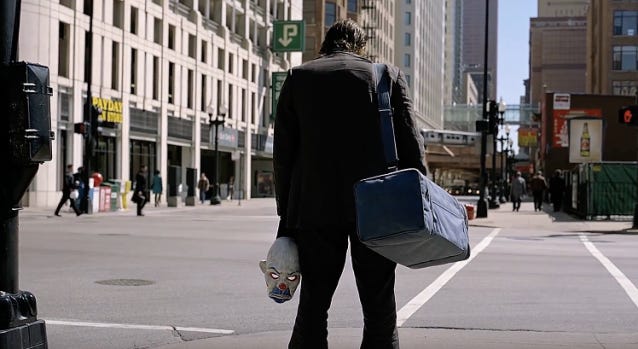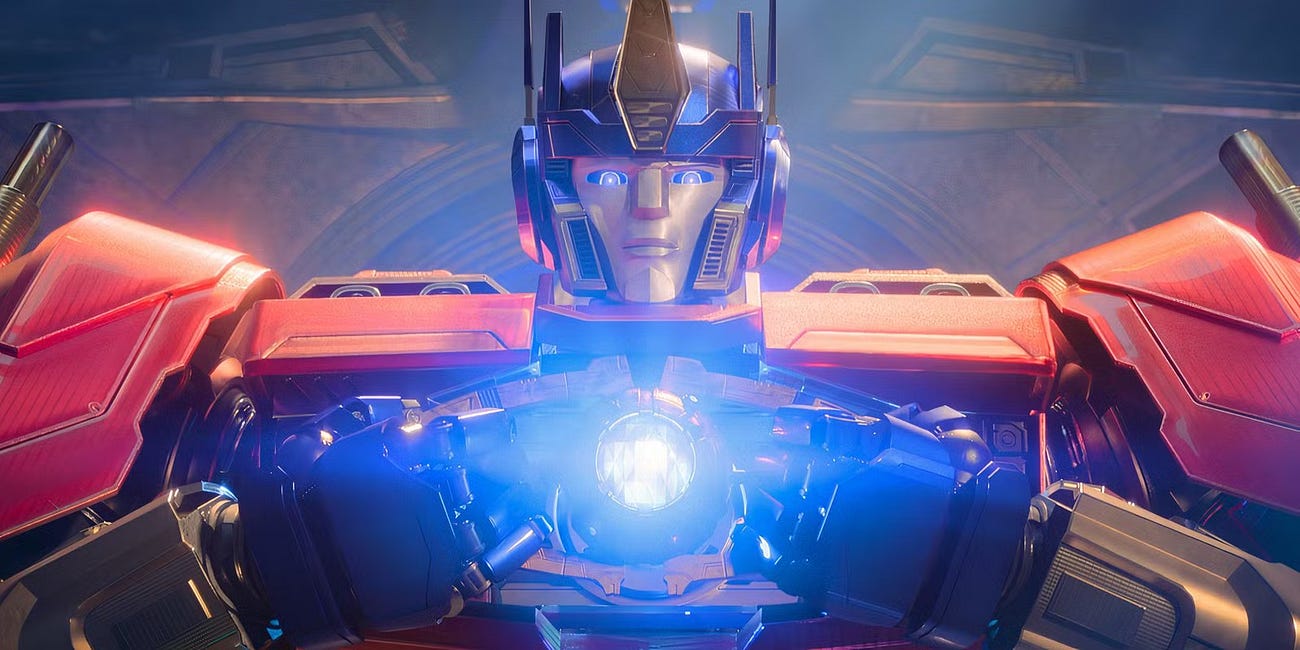Dark Knight, Dark Lie
Why Nolan’s Batman Could Never Save Gotham.
Caped Crusader, Captive System: How Nolan’s Dark Knight Trilogy Exposes the Myth of Heroic Reform
12 The Dark Knight Trilogy isn’t Batman’s hero’s journey, it’s his death march into the machine. By the end, the cowl doesn’t conceal a vigilante; it disguises another enforcer for a system that eats idealists alive.
Beneath the explosions, the gravel-voiced monologues, and the iconography of justice, this trilogy is a slow tragedy. It begins with a crusade to reform Gotham, detours into control masked as heroism, and ends with the quiet betrayal of revolution. The Dark Knight Rises dares to flirt with systemic collapse, but ultimately backs away, retreating into the comfort of myth.
This isn’t a story about saving a city. It’s about how even the best intentions become footnotes in a system that never truly changes.
Act I: The Delusion of Reform
Batman Begins is a lie Bruce tells himself. He returns from exile not to tear down a broken system, but to heal it, gently, surgically, and from the top down.
He’s seen injustice, trained with radicals, and walked away from extremism, but the lesson he brings home is one of control, not revolution. He thinks he can fix Gotham with his wealth, his training, and his moral clarity. He believes in the people. He believes in institutions. He believes that justice can be restored without ever questioning what justice serves.
This is the delusion of liberal reform: the belief that corruption is an exception, not a feature. That crime is a glitch, not the intended result of a system built to protect wealth and punish desperation. That all Gotham needs is a better class of hero.
Bruce funds Harvey Dent. He trusts Jim Gordon. He relies on Lucius Fox. All three are good men, but all three are working inside a machine that’s rotting from the core.
He fights symptoms, mobsters, petty crime, fear itself, but never the causes. He targets the underworld while Wayne Enterprises continues its quiet march toward militarization. He calls for justice while dodging any real reckoning with the structural violence that defines Gotham.
He never asks why the League of Shadows wants to destroy the city, only how to stop them.
Ra’s al Ghul tells Bruce that Gotham must fall. Bruce insists it can be saved. This ideological rift, collapse vs. reform, is the trilogy’s true conflict. And it’s Bruce’s side that ultimately loses.
The reforms were cosmetic. The rot was systemic. And the foundation was already cracking.
Act II: The Pivot to Control
Batman Begins ends with a promise, reform, redemption, a city slowly stitched back together.
The Dark Knight opens with reality setting that promise on fire.
Faced with a city that refuses to be saved, Bruce doesn’t adapt. He escalates.
Reform gives way to preemption. Hope curdles into domination.
The man who once refused to execute becomes Gotham’s masked enforcer, wielding fear, surveillance, and silence.
The Joker doesn’t corrupt Bruce. He reveals him.
Bruce doesn’t abandon Rachel to save Harvey. He tries to save her, and Joker manipulates him into saving Gotham’s "White Knight" instead.
But that manipulation only exposes the deeper rot:
Bruce's faith isn’t in people. It’s in symbols.
Even when it costs him Rachel, even when it shatters his soul, he doesn’t stop to mourn. He doesn’t tell the truth. He doesn’t grieve for Gotham’s real wounds.
He builds myths.
He turns Dent into a monument. He turns surveillance into salvation.
Joker never needed the ferries to blow. He never needed Gotham to turn on itself. He only needed Bruce to break, and he did.
Batman doesn’t defeat corruption. He becomes its crisis PR team.
When Gotham’s Narrows collapsed under fear toxin, Bruce had no antidote ready. He couldn’t save the people in the Narrows, not because he didn’t care, but because saving the city meant sacrificing the poor. Maybe that was the moment the line blurred.
When Gotham’s spirit collapses under Joker’s chaos, he has no faith left. Only fists, fear, and control.
Gotham keeps its soul. Bruce loses his. The trade was never fair.
Act III: The Cowardice of Legacy
The Dark Knight Rises isn’t an ending, it’s a confession. A billionaire’s final act of mythmaking, not for the city, but for himself.
Bane doesn’t bring anarchy. He brings consequence. He’s not Gotham’s reckoning, he’s its record keeper.
He drags truth into the light:
A justice system built to protect the powerful
An unnamed economic apartheid that built his army
A savior myth that trains citizens to wait for rescue instead of reclaiming power
And Bruce’s response? Not atonement. Not solidarity.
Restoration.
He becomes exactly what Ra’s al Ghul warned he would: a man who mistakes control for peace.
The moment the people rise, he returns, not to protect them, but to put them back in place.
He allies with 3,000 trapped officers, liberating them not to fix a system, but to reinstall one. The cops charge down the streets like an occupying army in blue. No reckoning. No reform. Just rearmament.
Even Bruce’s final sacrifice is rigged for theater.
The bomb is real. But the martyrdom isn’t. The autopilot was fixed months earlier. The explosion, the statue, the mourning, it’s all sleight of hand.
Because the truth would collapse the myth:
That Harvey Dent’s legacy was soaked in blood
That Batman’s war birthed Bane
That Gotham’s salvation required submission, not liberation
And when it’s over? Bruce doesn’t rebuild. He retreats.
He leaves behind:
A city that learned nothing
A police force baptized in iconography
Another orphan soldier handed the mask
The cycle completes. The machine lives. The cave gets a new bat.
Selina Kyle: The Escape Clause of Liberalism
She’s the perfect liberal foil, a revolutionary who never revolts.
A thief who raids the system, not to topple it, but to buy her way out.
From the start, Selina plays both sides:
She robs the rich but covets their parachutes
She mocks Bruce’s privilege while reaching for his hand
She warns of a storm, but never plans to stand in the rain
Her line—“There’s a storm coming, Mr. Wayne...”—isn’t prophecy. It’s a veiled appeal: buy me safety before the sky falls.
When the revolution arrives, she follows the playbook of the performative ally:
Performative Solidarity
She helps orphans, after securing her exit
She fights Bane, once escape is possible
She condemns the elite, while pocketing their currency
The Clean Exit
Her goal isn’t justice, it’s erasure
Not dismantling power, but disappearing from its ledger
Not liberation, but a villa in Florence
The Final Betrayal
She saves Bruce, not Gotham
She chooses love over loyalty
She leaves behind those who bled for a future she’ll never claim
The Message Is Clear:
Revolution is for the desperate.
The shrewd cash out.
Selina gets her ending because she never threatened the system.
She danced with critique just long enough to feel righteous, and bolted when the floor gave way.
In the end, she doesn’t remove the mask.
She just changes the one she wears.
But even captured myths carry embers.
Even systems built to cage breath can't kill it completely.
The mask survives. But so does the memory of the face beneath it.
The story isn’t over.
It never was.
If this breakdown challenged how you think about heroism and power, this is just the beginning.
Subscribe for future critiques that refuse the myth of easy saviors, and remember, the real stories worth telling are the ones we haven’t built yet.
Batman thinks he’s fixing the city. Joker just shows him what the system protects.
Freedom in name, reform in costume. Neither story dares to truly unmake the throne.
Special thanks to Joy for reading this piece in its raw form, pushing it harder, and helping sharpen it into something fiercer.
Good critique makes better stories. Good stories make better revolutions.
Citation Note:
This essay was independently written but informed by years of engagement with critical media analysis. Any conceptual overlaps with other creators, whether academic, essayist, or video-based, are coincidental or reflect shared thematic concerns within political film criticism. Notable thinkers who’ve shaped the critical lens behind this piece include:
Mark Fisher (Capitalist Realism)
bell hooks (on representation and systems of power)
Jacob Geller, Maggie Mae Fish, and Lindsay Ellis (for form, tone, and thematic dissection)
And a general engagement with abolitionist and post-structuralist critiques of media mythology
All interpretations are my own unless otherwise linked or quoted. If you recognize a specific line of thought you'd like me to cite directly, I’m always open to transparent credit and dialogue.
Disclaimer: The Dark Knight Trilogy, its characters, settings, and related media are the property of Warner Bros. Entertainment Inc. and DC Comics. This essay is a work of independent criticism and commentary, protected under fair use for the purposes of scholarship and critique. No affiliation or endorsement by Warner Bros. or DC Comics is implied.
Disclaimer":
The Dark Knight Trilogy, its characters, settings, and related media are the property of Warner Bros. Entertainment Inc. and DC Comics. This essay is a work of independent criticism and commentary, protected under fair use for the purposes of scholarship and critique. No affiliation or endorsement by Warner Bros. or DC Comics is implied.
Author’s Note:
This piece critiques the systems Nolan explores, not to lionize him, but to interrogate how even “serious” cinema can end up affirming the status quo. I hold all creators to the same standard: if a story protects power more than people, I’m going to ask why.
Note: Military Involvement in The Dark Knight Rises
While this analysis focuses on the thematic subtext of Nolan’s trilogy, it’s worth noting that The Dark Knight Rises received support from the U.S. military during production. Military technical advisors were involved, and the U.S. Marine Corps provided assistance for specific scenes.
This matters—because when institutions like the military contribute to film production, it often shapes tone, representation, and narrative scope.
This isn’t conspiracy. It’s structure.
And structure always leaves fingerprints on the script.
Learn more via SpyCulture and Military.com.
© 2025 Offscreen Observations. All rights reserved.
This article may not be reproduced, reprinted, or reposted without permission. Excerpts and quotes are welcome with attribution.




